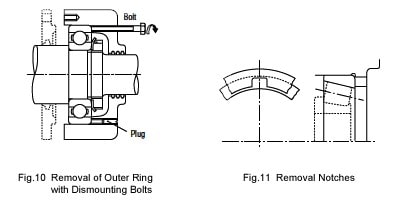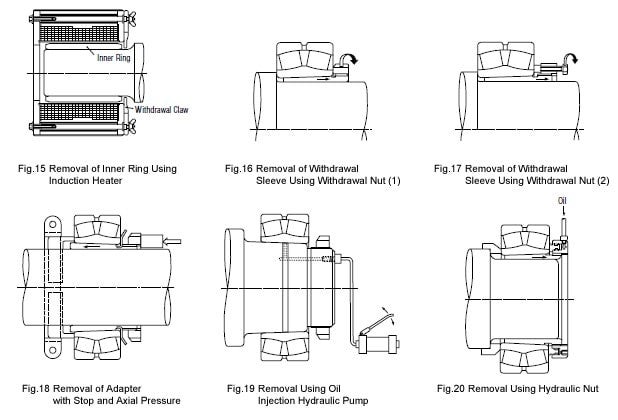Dismounting
A bearing may be removed for periodic inspection or for other reasons. If the removed bearing is to be used again or is removed only for inspection, it should be dismounted as carefully as when it was mounted. If the bearing has a tight fit, removal may be difficult.
The means for removal should be considered in the original design of the adjacent parts of the machine. When dismounting, the procedure and sequence of removal should first be studied using the machine plan and while considering the type of mounting fit in order to perform the operation properly.
Dismounting of Outer Rings
In order to remove an outer ring that is tightly fitted into a housing with push-out holes, first place bolts in the push-out holes at several locations along the circumference as shown in Fig. 10, and remove the outer ring by uniformly tightening the bolts. These bolt holes should always be fitted with blank plugs when not being used for dismounting.
For separable bearings, such as tapered roller bearings, some notches should be made at several positions in the housing shoulder, as shown in Fig. 11, so that the outer ring may be pressed out with a dismounting tool or by tapping.

Dismounting of Bearings With Cylindrical Bores
If the mounting design allows space to press out the inner ring, this is an easy and fast method. In this case, withdrawal force should be imposed only on the inner ring (Fig. 12). Withdrawal tools like those shown in Figs. 13 and 14 are often used.

In both cases, the claws of the tools must substantially engage the face of the inner ring; therefore, consider the size of the shaft shoulder during design or cut grooves in the shoulder to accommodate the withdrawal tools (Fig. 14).
The oil-injection method is usually used for the dismounting of large bearings. Oil pressure is applied through holes in the shaft, allowing for easy dismounting. For extra wide bearings, the oil-injection method is used together with a withdrawal tool.
Induction heating is used to remove the inner rings of NU- and NJ-type cylindrical roller bearings. The inner rings are expanded by brief local heating, and then removed (Fig. 15). Induction heating is also used when mounting several of these bearings on a shaft.
Dismounting of Bearings with Tapered Bores
When dismounting relatively small bearings with adapters, the inner ring is held by a stop fastened to the shaft and the nut is loosened several turns. As shown in Fig. 18, this is followed by hammering on the sleeve using a suitable tool.
Fig. 16 shows one procedure for dismounting a withdrawal sleeve by tightening the removal nut. If this procedure is difficult, it may be possible to drill and tap bolt holes in the nut and remove the sleeve by tightening the bolts as shown in Fig. 17.
Large bearings may be removed easily using oil pressure. Fig. 19 illustrates the removal of a bearing by forcing oil under pressure through a hole and groove in a tapered shaft to expand the inner ring. The bearing may suddenly move axially when the interference is relieved during this procedure, so a stop nut is recommended for protection. Fig. 20 shows a removal method using a hydraulic nut.

